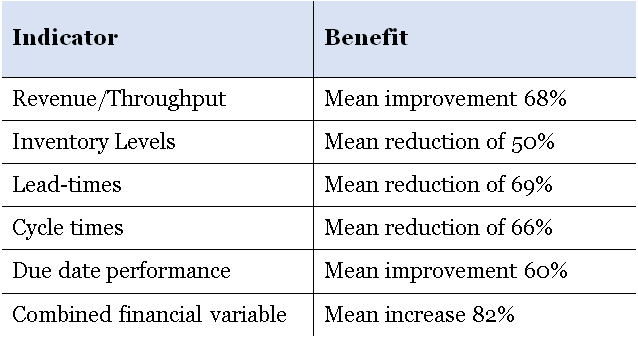
Operations | Organisation | People | Process | Strategy
STAY CONNECTED AND SIGNUP TO RECEIVE INSIGHT updates
As big and bold as the Theory of Constraints (TOC) is, it’s not sufficient, alone, to deliver on its inherent potential. As trains need track and ships need water, TOC needs a cultural and organisational infrastructure to get you to where you want to go.
[Listen to audio version, read by David Hodes]
Adam Smith had it right when he wrote, ‘The theory that can absorb the greatest number of acts, and persist in doing so, generation after generation, through all changes of opinion and detail, is the one that must rule all observation’.
Goldratt developed his theory as he stood on the shoulders of giants. Many who have followed him have used the vantage point of his shoulders to explore and discover ever deeper horizons. The reasoning that informs the theory and its associated methods and tools is rock solid. Overwhelming is the empirical evidence of its success as a practical source of remarkable results which would otherwise be considered unreasonable or impossible.
So why is it so often the case that it is the road less travelled? If the insights it provides to the science of planning and performing work are so valuable, why do so many not know of it, dismiss it, or fail to embed it as the enterprise’s way of working?
Before addressing that question, let’s celebrate—on this tenth anniversary of Goldratt’s passing—the breadth and depth of his monumental accomplishment in establishing and contributing to the ever-growing TOC body of knowledge. No other improvement method—Lean, Six Sigma, Agile or any other—covers the scale and scope of the problem domains TOC can systemically improve. And all of these problem domains are addressed within a single operating philosophy that uses common concepts and language throughout, uniquely making possible a methodical, enterprise-wide approach to the planning and performance of work.
We begin with the straightforward idea that all systems have constraints. We know the truth of such an idea because systems could produce an infinite output for a finite consumption of resources if it were not the case. Thus, correctly identifying this constraint on unlimited output provides us with the best possible lever to manage the flow of value. And, in that idea is the genius of the Five-Step FOCUS, the foundation of all constraint-based system thinking:
- Find the Constraint
- Optimise it
- Collaborate around that proposition
- Uplift the Constraint
- Start Again
Along with this undergirding idea are what we at Ensemble have come to call the universals: the Logical Thinking Process as a means of constructing, testing and communicating the rigour of your reasoning; and Constraint Accounting, which provides a suite of managerial measures that ensure behaviours at the local level always align with what is best for the organisation as a whole.
Following on from the universals are the proven solutions which address Project Management (Critical Chain), Production Management (Drum Buffer Rope) and Replenishment (Dynamic Buffer Management). Why do these solutions go by the name of proven solutions? Well, the results speak for themselves:
Review of TOC, Balderstone & Mabin, 1997
So, what are the missing pieces?
Given all of this know-how available to produce quite stellar outcomes, how come it’s necessary but not sufficient? Well, one reason is that there is nothing to create buy-in. We humans do not make decisions based on reason alone; we need stories about heroism to help us overcome the deep anxiety we feel about the scale and scope of change demanded by adopting a new operating philosophy such as TOC. We are deeply anxious about having to learn new ways of knowing and new ways of being. What if I’m not up to the mark? What happens if the basis of my power is my knowledge of how the current system works, and this newfangled system will make that knowledge obsolete? How will I retain my authority as I stumble on the learning I have to do to gain mastery in this brave new world? And, what if it fails?
It is remarkable, but true, that even when we are in trouble, we’d often rather stick with the devil we know than try something new. The bindings of the extant culture may be invisible to the eye, but that doesn’t mean they’re not every bit as restrictive as a physical chain might be. Relationships have been carved out over months, years, and sometimes decades, and the patterns of behaviour they generate are monumentally challenging to shift. A perturbation to the geometry of power will not pass without consequence.
“We are deeply anxious about having to learn
new ways of knowing and new ways of being.”
It’s never simply at the level of self that these changes have to occur, difficult as that is. No, we have our teams and tribes to deal with, each with their sub-cultures and ways of knowing, acting and feeling. A change as consequential as introducing a wholly new operating philosophy will dissolve the limiting order of the caterpillar and turn it into a chaotic, undifferentiated goo before we’re able to realise the beauty of the butterfly contained within. Everyone will need to go through their own change experience while simultaneously participating in the formation of new teams and ultimately an entirely new organisation.
To gain buy-in under such circumstances, we have to, at a minimum, understand the principles of the learning organisation, so clearly articulated by Peter Senge in his seminal book, The Fifth Discipline, which includes:
- Personal Mastery
- Mental Models
- Team Learning
- Shared Vision
- System Thinking
We will never achieve what we set out to do without putting human flesh and spirit on the bones of operational excellence. We must overcome the voice of judgement that tells us we’re not good enough. We must quiet the voice of cynicism shielding us from the enrichment that comes from opening our more vulnerable side to the experience of feeling deeply into our sense of connectedness to ourselves and each other. And yes, we must still the tremulous voice of fear that worries about letting die that which must pass if we are ever to make way for that which is true, beautiful and good.
Diving deep into the world of organisational learning gives us new ways of seeing and sensing the world around us. We can progressively become more comfortable with the idea of embarking on our own hero’s journey and ask deep questions about what our future of highest potential might be. We can trade out our anxieties for the richer experience of living into a vision propelled by aspiration. We can unlock the shackles of habit and allow for a life informed by curiosity, wonder and experimentation. In learning how to change ourselves, from the inside out, we lead our teams and our organisations into the rejuvenating frontiers of experience.
Creating a requisite organisation
So now we have know-how with TOC and buy-in from addressing the challenges of organisational learning. But again, that’s necessary but not sufficient. We have no robust means by which we can run the accountability for this system of planning and performing work. For example, suppose we are to deal with all aspects of our organisation under the umbrella of a single operating philosophy, with its projects, production and supply. In that case, we will encounter the difficulty of defining, delegating and coordinating the activities across all these work types.
Projects might occur in product development, IT and capital works. We could use production methods for manufacturing, recruitment and software development and testing. We might adapt the replenishment methods for procurement management, sizing of the workbench and production planning and control. If we’ve got TOC, we have the know-how for all of these activities. If we diligently apply the principles of the learning organisation to all the people who work for us, we’ll get the buy-in. But we still don’t have a systematic approach to architecting and running an effective management accountability hierarchy.
The Requisite Organisation provides just such a systematic approach to the design and operation of an effective structure. It provides a way of closing the accountability gap. Through the work pioneered by Elliott Jaques, we see the three-way correlation between the time horizon of work, its complexity and the mental processing power required to address it. Understanding how this ‘Stratified Systems Theory’ works lets us correctly match people to the size of the job for which they’re accountable. Too big and complex, and they go home with ulcers. Too small and simple, and they become bored and mischievous.
Having people in roles suited to their capability is one part of a three-way puzzle. The second element is knowing how to give an effective delegation. At a minimum, the person you are holding accountable for doing the work has a right to know its Context, Purpose, Outcomes, Resourcing and Timing – often abbreviated as CPORT.
“Correctly match people to the size of
the job for which they’re accountable.”
Finally, you need to be clear about how you exercise your accountabilities within your silo and across those with whom you need to coordinate and collaborate. It is unreasonable for you to hold someone accountable for a piece of work if you are unwilling to provide them with authority over those resources considered necessary to acquit that accountability—whether they share the same line boss or report into a different part of the hierarchy. Moreover, besides the financial, material and human resources required to plan and perform the delegated work, the provision of timely relevant information, whether in the form of a CPORT or business intelligence analytics, is as much a necessary condition of effective management as all the others.
My favoured definition of leadership is that quality leaders bring to their work that has their followers do what needs doing without them having to resort to the authority of management. Careful consideration of the innovative application of relevant systems thinking methods and tools across the domains of operations, organisational learning and organisational design provides a much richer experience of work for leaders and followers alike. After all, since this is the only life we get to lead, it’s always More Than Just Work.
____________________________
What’s next?
The change from standard thinking to Theory of Constraints (TOC) is both profound and exhilarating. To make it both fun and memorable, we use a business simulation we call The Right Stuff Workshop.
We’d love to run it with you. To learn more:
- download the brochure (no email required)
- schedule a call
____________________________
[Background image: Two matchsticks, Devin Avery on Unsplash]
____________________________
Measurably reliable and agile
Few performance standards deliver the competitive advantage you gain by keeping your promise to deliver on time, doing so faster than your competitors, and suffering no defects while you’re about it.(more…)
Managing accounting’s relevance
Eli Goldratt famously said, ‘Tell me how you measure me, and I will tell you how I will behave. If you measure me in an illogical way… do not complain about illogical behaviour.’ If you measure and reward activity, then activity’s what you’ll get.(more…)
More than just work
Discover better ways to do better work.
Fresh insights, every Friday
We alternate our own actionable articles with three relevant links from other authorities.
We’ll only use your email address for this newsletter. No sales callsMore than just work
Discover better ways to do better work.
Fresh insights, every Friday
We alternate our own actionable articles with three relevant links from other authorities.
We’ll only use your email address for this newsletter. No sales calls
What is to get in touch with you?












